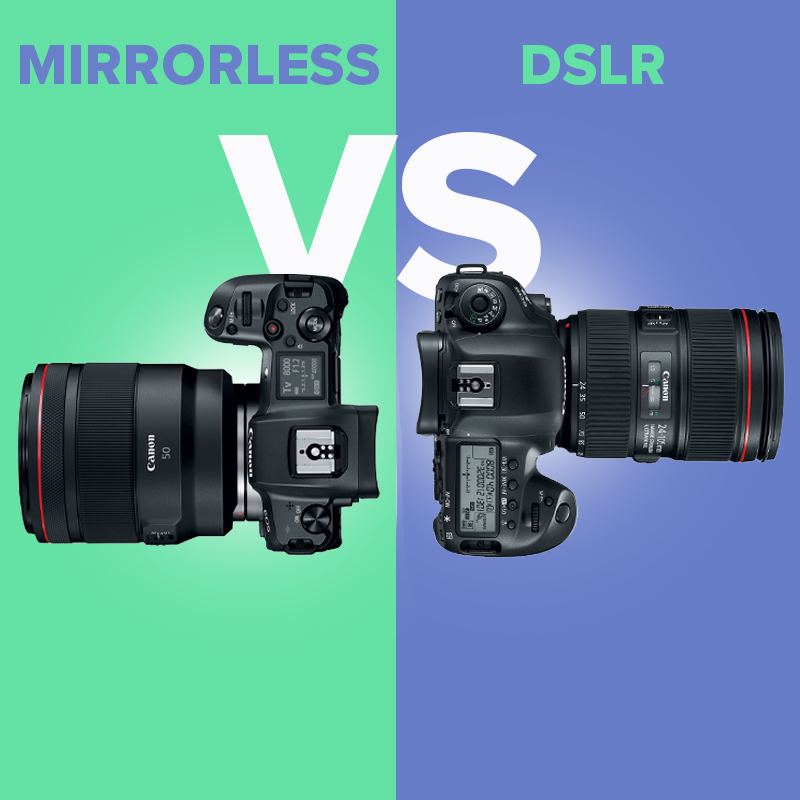The popularity of mirrorless cameras has recently skyrocketed, with more and more people looking to switch from their DSLR or add mirrorless cameras to their digital photography kits. But why? Mirrorless cameras are fairly new to the photography realm, with Canon and Nikon announcing their first full-frame mirrorless systems in late 2018, and Panasonic joining the game in March 2019. Historically in the digital imaging industry, it was thought that the more robust your camera, the better. But small, sleek, mirrorless cameras are changing the way we operate.
Why Go Mirrorless
-
Smaller and Lighter
With the mirror and pentaprism out of the way, mirrorless cameras can now have a more consolidated design. When it comes to a smaller, lighter camera, most people would agree it’s a plus, especially for traveling or for longer photoshoots. No one likes having their arm tired at the end of the day. In today’s world the smaller the better, as evidenced by the convenience of smartphones. Not only is it easy to take with you everywhere, but the camera function is simple and easy to use. Although you are foregoing image quality, convenience is what’s so attractive to most people. DSLR Canon 5D Mark IV vs. Mirrorless EOS R
DSLR Canon 5D Mark IV vs. Mirrorless EOS R
-
Quieter
In DSLRs, the mirror flips up as soon as you press the shutter to let light come onto the sensor, hence the loud clicking noise with every capture. In settings where you might not want a loud shutter, like a funeral, wedding, or even a safari or other nature photography where the subjects may become startled, mirrorless cameras can come in handy. Instead of hearing both the mirror and shutter click, you will only hear the shutter. You also have the ability to make your camera completely silent when you use the electronic shutter feature. -
Less Camera Shake
In addition to allowing the camera to be quieter, the absence of the mirror helps with less camera shake. Your imagery is sharper and clearer right from the first shot, and you won’t miss a moment of the action when shooting sports, wildlife, or other fast-moving objects. -
Easier to Clean
When you go mirrorless, you’ll soon discover that the mirror doesn’t need to be locked up, which also means your camera doesn’t need to be fully charged when cleaning the sensor. Plus, without the mirror, there are fewer places for dust to build up and get trapped behind, keeping your images error-free, which means less effort in image-editing post-shoot. -
Faster FPS
In DSLRs, the mirror is a major factor to how many frames per second your camera can take in continuous shooting mode. Without the mirror, this allows the shutter to open and close at a faster rate, especially if you use the electronic shutter. -
Cheaper to Build
Anytime a manufacturer adds elements, the cost goes up. The mirror and pentaprism in a DSLR consist of multiple parts and a complicated design, which costs more money to make—a cost that is passed along to the consumer. Without as many parts, mirrorless cameras are cheaper and quicker to develop. Since mirrorless cameras are cheaper to build, camera companies can lower the price, making mirrorless cameras more affordable for the average consumer. DSLR Nikon D750 vs Mirrorless Z6
DSLR Nikon D750 vs Mirrorless Z6
-
Live View
Electronic viewfinders (EVF) have a huge advantage over the typical Optical viewfinder (OVF). For one, you have the ability to display several types of information; whether that’s real-time exposure data or histograms or even being able to see a preview of your image after it has been taken. With focus peaking, it cuts out having to just rely on your eyes when using manual focus. The area that is in focus gets highlighted with an overlay color, making it easy to determine what is in focus or not. Plus, in dark lighting situations due to live view with ISO, you will be able to see a brighter image. -
No More Calibration Issues
Calibrations simply aren’t necessary with a mirrorless camera—without a mirror, there is no opportunity for a mirror to come out of alignment. This saves you time and money, and keeps you from having to deal with focusing issues. -
Face/Eye Tracking
The phase-detection autofocus system in a DSLR works by directing a portion of the light that comes in through the viewfinder to a second autofocus sensor. This has worked for DSLRs, but mirrorless cameras use different methods. These can include on-sensor phase detection, contrast-based autofocus and depth-from-defocus. These new methods offer mirrorless cameras better autofocus performance and with that comes new face and eye-tracking capabilities. -
Increased Autofocus Points
Due to on-sensor phase detection in mirrorless cameras, focus points are distributed over most of the sensor, even all the way to the extreme borders. This isn’t the case with DSLRs and most focus points are located mainly in the center of the frame. -
Newer, Better Lenses
Compared to lenses made for DSLRs, mirrorless lenses will be equipped with a short, wide lens mount. This allows for a large element to be placed in the rear of the lens which can reduce chromatic aberrations. It also means that the lens can be produced with fewer parts and can be made into more compact sizes. These new lenses support a higher pin connection count which provides better communication between camera and lens. This enables faster data transfer, fast autofocus and enhanced image stabilization. Plus, if you have invested in previous lenses, with the addition of an adapter, you will still be able to use all of them.


2 comments
Pictureline
Hi Kelly, that’s definitely another added benefit. Without the mirror, there’s more of an opportunity to implement in-body stabilization.
Kelly
The new M5 is supposed to have in-body image stabilization. You can’t do that with a DSLR.